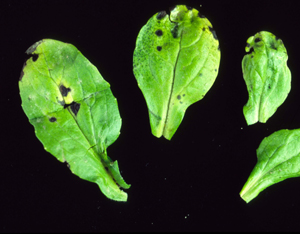Acidovorax valerinellae
Acidovorax valerinellae
Damage symptoms

Initially, dot-shaped, dark green, greasy shiny spots can be seen on the leaves, which are later surrounded by a yellowish yard. The spots turn black as they progress, grow up to 4 to 5 mm in size, are roundish to irregular, and eventually rupture. At the edges, the spots are sharply demarcated from healthy tissue. Leaves of any age are susceptible. The spots may appear on the entire leaf and on the leaf margins. In severe infestations, leaves turn yellow and die. Secondarily, other bacteria as well as gray mold can also cause rot at infested sites.
Host plants
The only known host plant at present is lamb's lettuce(Valerianella locusta).
In 2001, a susceptibility test of existing lamb's lettuce cultivars was conducted, and all cultivars were equally susceptible to Acidovorax valerianellae. Only two wild varieties were not infected by the bacterium.
Propagation and transmission
Prolonged periods of leaf wetness, e.g. after prolonged rainfall or irrigation measures, promote infections and the spread of infestation. In the field, therefore, an occurrence of the disease must be expected in spring and fall under warm and humid conditions. In packaging, the bacterium can continue to develop on the finished goods for sale, and the bacteria can persist in the soil. Furthermore, transmission with the seed is possible.
Economic importance
More severely infested plants are no longer suitable for marketing. In the case of minor infestation on the outer leaves, these can still be marketed by increasing the cleaning effort. If infested areas are overlooked, this may result in major damage during transport and storage, also due to secondary bacterial infestation.
Prevention and control
- Use of healthy seed
- Avoid prolonged periods of leaf wetness if possible.
- Do not recultivate lamb's lettuce on plots where the disease has occurred until at least two years have passed. The more often lamb's lettuce follows itself (even within a year), the more the disease can spread to subsequent stands
Last updated: 03.11.2021
automatically translated